|
UP THE HUDSON RIVER TO
TARRRYTOWN Larry has me take the boat out of Liberty Island Marin, our marina across the Hudson River from Manhattan, on the New Jersey shore, as Dave and Larry pull in the fenders and stow the lines. The day is nippy but clear and we have energetic 15 knot winds clipping across the river. It was so amazing to glide past the Manhattan skyline again. You just canít imagine the site, itís almost unbelievable. It literally just takes your breath away. We dodge the many ferries that are running back and forth across the Hudson to the other side and the tour boats taking crowds to see Ellis Island and the Statue of Liberty. We chuckle at the funny little yellow river taxi (like a checkered cab) that zips by like a little cartoon character. This week is the start of the Rolex International Atlantic Sailing Challenge and we see huge (and I mean HUGE) yachts docked at the Financial District Marina. These huge monsters are gathering all over the area getting ready for the start of the race on the 21st of May. It was so exciting to see them. Today was going to be a short trip of about 30 miles up the Hudson River to Tarrytown and the start of our adventure up the Hudson River Valley. We were taking it slow to see the sites. The current is running against us about 2 knots so weíre plowing at a slow 6.60 knots. Weíre in no hurry and enjoying the scenery. We pass the new waterfront built after 9-11. It is filled with joggers, children playing and mothers visiting and walking strollers, people swinging on a trapeze training area right on the river front, basket ball courts filled with sweaty participants with shirts tied around their waists and heads. These New Yorkers are enjoying this park like you wouldnít believe. They are getting every once out of it. We pass upper Manhattan and the skyline is dwarfed in comparison to the Financial District even with the loss of the Twin Towers. We see the Empire State Building and the beautiful Chrysler Building. I think I saw a glimpse of King Kong for a moment, hanging off one side and he was waving at us. We checked out the marinas on
the Manhattan side that we might stay in on the way back. The first one is
Surfside 3, at the Chelsea Piers. It has an outdoor net covered 4
tiered golf range, swimming pool, and Silver Screen Movie Studios in the
surrounding complexes. Itís between 17th and 23rd
street. Itís right next to the red, white and blue pier buildings which
have several restaurants.
I went to sit out on the back deck to watch the city as we left it and almost fell out of my chair as a huge 146 foot racing ketch drifted by called Mari-Cha IV,. The crew was all standing on the center of the boat in a serious meeting, like a huddle in football, planning their winning strategy. Guess they were discussing their plans for the big Transatlantic Challenge Race. It was amazing to watch this monster cruise by. It was by far the most impressive sailing vessel Iíve ever scene cruising on the water. It has a crew of about 20. We passed the end of Manhattan Island. This is where the East River becomes the Harlem River which joins into the Hudson River making Manhattan a legitimate island. There is a small RR bridge that requires an opening for any boats wishing to go through. At the time we passed, a tour boat coming behind us, up river, was requesting an opening from this little bridge called Spuyten Duyvil RR Bridge (pronounced ďspite-en die-vilĒ. It was the beginning of our introduction to Dutch names. We will soon encounter many more on our journey up the Hudson River. We could hear the bridge tender for Spuyten Duyvil RR Bridge tell the tour boat on Channel 13 that it would have to wait to for two trains to cross first. We could see the tour boat lagging back waiting for his turn. We looked ashore and saw the first train coming and in the distance the other waiting for the first train to pass so that it could then have priority on the track and cross the bridge. We were soon to find out that the train tracks hugs the shore of the Hudson River all the distance that we traveled. They are like a constant companion and though large and grand, they will soon become dwarfed by the huge magnificent landscape of the Hudson Valley, so much so that they sometimes just look like a toy trains, but busy toy trains transporting multitudes of New Yorkers as they commute to and from the busy city to the quiet country of the Hudson Valley. We passed under the George Washington Bridge (built in 1931) which has a more recent (about 30 years later) addition of a lower traffic deck which the quirky New Yorkers have slyly nicknamed, Martha Washington. At the base of one of the supports is a small red light house. Itís the same red light house that inspired the famous childrenís book, The Little Red Lighthouse and the Big Grey Bridge.
click on the camera for photos
Once past the George Washington Bridge, the city dissipates quickly. We pass Yonkers, an old industrial town from the view of the water front. The ghost of a huge old brick mill with two tall brick smoke stacks is still perching dominantly on the shore, no longer useful. Itís quickly being taken over by ivy. We will find abandoned industrial sites like this a familiar site as we head north. They are beautiful brick structures, no longer useful. Itís a shame as there is such beauty in its structure, detail and architecture. A time when industrial buildings were constructed with thought for detail and time and labor was not an issue as it is now. The left side of the river begins to climb in height as the sides become black stone cliffs topped with green multi shaded trees. Itís the beginning of what they call the Palisades. We pass the village of Piermont. It has a long point of land that juts out into the Hudson on our portside. Itís famous now a days as the home port of Pete Seegerís Clearwater sailing ship. We searched for it with our binoculars but werenít successful in finding sight of her. We are nearing our destination which is Tarrytown, or more familiarly known as Sleepy Hollow. We see the Tappan Zee Bridge which just south of the carefully marked entrance to our marina, Tarrytown Marina. We pass under Tappan Zee
Bridge
Larry had called the marina the day before to make a reservation and asked about the water depth. They told him the waters were deep enough for us (we have a 6 foot draft). They said to pick up the end of the first T and tie there. We saw it immediately as we entered. It was close to the entrance, actually the first row and we slowly maneuvered up to its side. Dave and I both jumped onto the dock to get the lines tied as the current was running a little. The dock was covered in geese shit! They were big turds much like a dog would leave and they were everywhere! If it wasnít a big turd it was white creamy splats and they were all pretty fresh and gooie. It was really awful. Once we got the boat tied we tried to get power and none of the hook ups were working. The docks were pretty rickety and moving up and down, making all sorts of creaking and groaning sounds. Larry tried to hail the dock master on the radio to see what the deal was with the electricity but got no answer so he decided to walk to the office and see if he could find someone. It must have been a ľ mile to the dock office or at least it seemed so. The dock office was only about 100 feet from us visually but Larry had to walk the dock we were tied to, down river, then reach the outer bulkhead and walk towards land and then just before land, the dock turned and returned back up river the same distance. It was comical and we all sat in the pilot house watching him remarking on how far it was. Larry was the size of a peanut by the time he got to the end of the dock. I was busy with the hose, power washing the wooden dock of the load of bird crap. It was disgusting but I was getting great pleasure out of the good job I was doing cleaning the dock. It was immediate gratification for a job well done seeing all that crap wash into the water surrounding the dock. It was so thick, the poop was spattering on the side of the boat so that when I felt I had done a good job clearing the dock of it, I then had to hose off the shit on the side of the boat. Larry was gone a lone time. Finally we saw him, again peanut sized, slowly heading back the long U-shape dock back to us. I was hoping they werenít going to reassign us to another dock with working electricity as I had done such a good job cleaning this dock and also thinking we should get a good reduction in price for all the hard work I had done. I could tell things werenít great because of the slow, methodic walk that Larry was doing. It was like he had a load on his mind and was working something out. At one point, he stopped and turned and started to walk back to the dock office, like he had forgotten something or had a question, and then he stopped again in his pace deciding, I guess, not to go back, and again started the long journey back. He stopped at several electrical boxes along the way, lifting the lids and examining them. Finally, what seemed like hours, he made his way back, and he merely said ďno one was thereĒ. I guess that during that thoughtful walk back, he was trying to figure out if an electrical panel for the marina had gone out so he was checking things all the way back. His mind is the sort that if there is a problem he works on trying to fix it. Iím sure thatís what he was doing. We decided to stay put as we only had 6Ē under us and figured it could only get worse moving to another dock closer to shore. I was happy because my dock was really nice and clean. We had a quick lunch on the boat and then gathered our gear to make a walk to the town of Tarrytown. By the time we walked the docks, we felt like we had had a pretty good hike already. The dock master was in his office by now, and Larry told him his power was out. In what Iíd call a cocky New York attitude, the dock master said ďit had to be our boat and not his dockĒ. We laughed thinking he was being funny but soon realized his smart comment wasnít meant for laughter but that he was serious. Larry made a few suggestions on what he thought it might be like a breaker out, etc. but you could tell right away this guy didnít appreciate any help or friendly suggestions. We kind of shrugged our shoulders and headed out to find the town.
TARRYTOWN (SLEEPY HOLLOW) The railroad runs the shores of the Hudson, so we first had to get over the RR tracks to see the town. These were busy tracks for the commuters and weekenders coming in and out of NY. We hiked up the stairs and over the pedestrian bridge to the other side and down the steps to the street. We asked a local which way to town and they pointed to the top of the very steep hill. The weather was warming up. We were already getting hot and tired and had barely gotten out of the marina. We slowly but steadily climbed up the steep hill that seemed to get bigger and bigger as we got farther up. The road climbing the hill curved around the hillside and just continued onward and upward at every turn. Finally though we were rewarded with an encouraging glimpse ahead of the charming main street lined with trees, old quaint storefronts, nice boutiques, cafes, a famous old historic theatre, and a great dog friendly coffee place. We headed straight to the
coffee place, to get our afternoon caffeine fix and rest after the long hike.
Our new guests were putting up a good front but we knew, having just arrived
late yesterday from California that they must be feeling jet lag big time though
wouldnít admit it. The townís people were super friendly.
The coffee cafť was called Coffee Labs. You canít miss it as there is a painted black stone statue of a black lab that greets everyone at the front door step. It is the gathering place for all the locals. Itís about midway up the Main Street on the left side. Dogs are welcome inside as there are no tables and chairs on the sidewalk. The walls are filled with dog memorabilia even in the bathroom. The people were so friendly and very interested in our trip and Ziggy. After regaining some energy we set out to find a grocery store nearby. No one was in the mood for a long walk to see Sleepy Hollow by foot. We decided weíd rent a car at the next stop up the river and see the surrounding area of Sleepy Hollow by car as nothing was within walking distance. We were leaving in the morning so after walking the town and getting some groceries we headed back to the boat for dinner and a good nights rest. The town is a great destination. Not far from NYC. We could still see the NY Skyline though we were 20-25 miles north. This is the home of Washington Irving who you all know wrote The Headless Horseman and Rip Van Winkle. These stories were some of my favorites as a kid growing up so I was very interested in seeing the sites that inspired Irving to write these marvelous tales. Irvingís home, Sunnyside, is available to visit. The Sleepy Hollow cemetery is near town and many of the family names included in his stories are visible on the head stones. Itís truly worth a visit just for the antiqueness of it. Nearby is location where the bridge that the Headless Horseman and Icobad Crane galloped across. Now it is a concrete bridge, still picturesque and full of images of the stories. The old grist mill is nearby. Itís a long walk from the marina to see these and the nearby Rockefeller estate known as Kykuit. Coming up the Hudson by boat, though beautiful, we soon realized that to see beyond the river views it will require renting cars at each stop. So tonight, is time for our jet weary friends to acclimate. But weíll be back in a couple days by car to visit this town that the Dutch farm wives named Tarrytown because their husbands tarried too long in the taverns. Today we were not going to tarry long though we would have loved to have time it to see Dave Bruebeck playing the next evening in the historic (1885) Tarrytown Music Hall on Main Street. A charming place this is.
click on the camera for photos
We left at a leisurely hour for us, which was about 10:00 AM in the morning. Zig and I had time to walk the Main Street again before we left. The historic theatre was bustling with people as they were filming a commercial. People that we had seen the day before at the coffee hangout said ďhelloĒ and wished us a great summer. What a great place Tarrytown is. The morning we were leaving, the dock master had many of the boards on our dock torn up looking for the electrical problem. He finally found the problem just as we were getting ready to leave. He made a point to call Larry out of the boat to show him that a bolt in the dock had managed to work its way down through the dock and was shorting out an electrical line. Well, glad they found it. It didnít bother us much as we had plenty of power on the boat anyway. We slowly pulled off the dock and turned the boat. The props and thrusters were stirring up the mud bottom as it was very shallow. We slowly and carefully crept out, weary of the shallow depths and strong currents in this river. As we made it to the bulkhead we passed the small old lighthouse at the entry, one of the oldest on the river. We were heading north up the Hudson River to the town of Newburgh. It would be our base for a couple days. We will rent a car and see some of the surrounding areas. Across the river from Tarrytown is the town of Nyack. Itís supposed to be a charming town and recent claim to fame is that Rosie OíDonnell live there, but we wonít have time to stop there. We could see many boats moored, all sailboats except for one boat close to shore that looked like a Nordhavn. Maybe weíll pass each other somewhere further on up the river.
ďSING SINGĒ Our next town of interest that we would be passing is Ossining or better known as ďSing SingĒ home of the New York State prison. Now I understand what they mean when they say to ďsend him up the riverĒ. Guess you can actually visit the prison and see the electric chair and a life size replica of a prison cell. The prison was built in the 1829ís and finally abolished capital punishment in 1965, only to reinstate it in 1995 but no electrocutions have taken place since 1963. It was kind of ominous to cruise by the ďpenĒ wrapped in bobbed wire with the guardís towers hovering over. Itís built right on the bend of the river. We were expecting to see mansions not prisons on this trip. As we pass Ossining the river widens to its widest point. We pass more of the majestic palisades on the left. Just past the palisades is Haverstraw Bay on our left. It has a huge marina that we will stop in over night on our way back down to New York. Just north of Haverstraw is Stony Point Battlefield where General Anthony Wayne led a small group of men at midnight through the marshes to surprise and overtake the British during the Revolutionary War. It was a small victory but the psychological impact gave our troops a positive boost in moral that was greatly needed at that time. DUTCH GOBLIN Further up on the port side is Dunderberg Mountain which juts out into the river creating a blind curve. Itís the start of the highland area. It is said to be the home of the Dutch goblin that is responsible for summer storms. He has been good to us so far but will turn his hand as we head farther north. We are now entering the start of the Appalachians and the scenery immediately becomes stunningly more beautiful. BEAR MOUNTAIN Bear Mountain State Park is on our left and is a lovely spot that we visited by car the next day from Newburgh. Has a huge wonderful old stone hotel, hidden from view of the river, that is presently closed for remodel. It was the place to stay for New Yorkers in the 1920ís, in fact, in order to be approved to stay there, one had to fill out an application and provide personal info before given the privilege to stay there. Itís pretty rustic looking now though. Inside the walls are adorned with mounted moose and elk heads along with a huge oil painting of Rip Van Winkle hanging over a great stone fireplace. It sets up from the river and hidden by landscape so it is truly a pleasant surprise to discover. Thereís a great spot to anchor nearby within hiking distance. The hotel overlooks the picturesque Hessian Lake (pond) at the base of the steep mountain. Itís truly picturesque. Just past Bear Mountain is The Bear Mountain Bridge. It is beautiful bridge stretching across the river at the mountainous bend. In 1924 it was the worldís largest suspension bridge but what is more interesting is that it serves as the river crossing for the Appalachian Mountain Trail. This is also the location that George Washington chose to have his army stretch a huge chain across the river to deter the British Navy from gaining access to the upper river area. Imagine a chain, whose links were two feet long and each weighed 140 lbs! How they could have possibly accomplished this task is beyond our comprehension. The chain was placed on a floating log boom and pulled across the river. The revolutionists did not succeed. The British came up river and quickly retrieved the chain and eventually shipped it to Gibraltar using the same idea to protect one of their own harbors there. WEST POINT
From Newburgh we rented a car and came back to drive by West Point among other sites along the river. In order to have a tour or visit West Point, since 9/11, prior arrangements have to be made. We didnít have the foresight or time to do that but we managed to get a slight peek though as they allowed us to go through the gates to visit the famous Thayer Hotel just inside the gates. It was exciting to walk inside the hotel and get a small glimpse of West Point life. Across the river is Constitution Island, the first place that Washington chose to fortify West Point. There are a few old structures there but mostly looks like whatís left of a peaceful farm estate. On our starboard side, we pass a quaint looking little town dock called Cold Spring Village that we will visit by car the next day. The dock has a wonderful little gazebo on the point and an old Tavern Inn that looks the same as it must have looked hundreds of years ago. POLLEPEL ISLAND
click on the camera for photos
NEWBURGH
Other than the fast boats, Newburgh has a nice waterfront with several restaurants at the docks. We had a lovely meal one night overlooking the marina. The down side is if you venture up the hill to town you discover a terrible ghetto. Itís a shame as the town has so much potential. We took a walk one morning but quickly decided it wasnít safe and returned to the sanctity of the marina. We made arrangements to rent a car for the next couple of days to see the surrounding areas that we had passed by boat and didnít have the time to or access to see them. LOWER HUDSON BY CAR Using a rental car and Newburgh as our base we set out across the Newburgh-Beacon Bridge to explore the East side of the river. Our plans were to drive south on that side and return back across the river over the Tappen Zee Bridge, making a full circle back up to Newburgh on the west side. We soon discovered the quaint charm that these little Dutch villages exude, lovingly know as the Hudson Highlands. They are reminiscent of scenes along the Rhine in Germany. We drove through the town of Beacon and marveled at the number of little art galleries. With so much to see in this whole area so little time, we had to narrow our destinations. We headed South on the highway and stopped for morning coffee in the charming riverside village that we had noted on the way up called Cold Spring Village. t was filled with small unique antique shops and with warm coffee in hand we walked down the small main street under the RR tracks to the old town dock stopping along the way to make a few purchases. Cold Spring Village is located in close approximation across the river to West Point. We poked around the River Inn and got back in the car heading down river.
We got back in the car again and headed south a few miles and turned right down
a meandering shady lane to Sunnyside, Washington Irvingís house where he wrote
his many wonderful stories. Again, itís a mythical place. The
grounds are green and lush and filled with amazingly expressive huge knarly
trees. The rhododendrons and vibernums are in full bloom and the
industrious Robins are pulling up long stretchy worms. It was springís
paradise.
TAPPAN ZEE & NORTH TO NEWBURGH ON THE WESTERN SHORE It was time to cross the river and head back northward to complete our circle from Newburgh. We crossed the wide Tappan Zee Bridge and headed north passing through Nyack, Haverstraw, Stony Point, and climbed the steep road cut into the edge of Dunderberg Mountain. The scenery is spectacular! As we climbed in elevation along the mountainous river edge we could see views and outlooks that are so reminiscent of the Hudson River painters who made this area so famous. It still looks much the same as seen in the many Hudson River paintings. The river meanders through the valley graced by hills and farms and ancient mansions. The mountains and hills are delineated in depths by various shades of colors and natural shading. Itís a magical land and so inspired so many creative people. We drove through the small unpretentious village that hugs West Point and decided the view was much better and more impressive from the water in our boat. You just donít get the massive impact of the academy until you see it precariously perched on the steep cliffs hovering over the Hudson. Soon we were back to our boat at Newburgh and the ridiculous rolling from the wakes by the inconsiderate boaters going by. We did our best to put it out of our minds and just enjoy the activity of the river. We turned in early to head on up the river to our next stop, Kingston, the following morning. NEWBURGH TO KINGSTON click
on the camera for photos
In the morning before we left, I gave Newburgh one last chance and walked up the hill to the town with Ziggy. I wanted to at least see Washingtonís temporary headquarters during part of the Revolutionary War. It is perched on a high spot of land and has an imposing fortress like wall surrounding it. A fieldstone cottage was inside the wall. That was the cottage that he headquartered in and is well preserved. Other than that, there are many wonderful old buildings well worth preserving in the surrounding area and I must say itís difficult to look at them in their bad shape. I hope time acts quickly to preserve these worthy buildings before hard times completely destroy their past. Heading north under the Newburgh-Beacon Bridge and towards Poughkeepsie began the beginning of some of the most scenic areas so far of this great river. Unfortunately there still are remnants of substantial industry on the river that are certainly eye sores. We saw our fill of old abandoned factories, gravel piles, nuclear plants, and active concrete plants which are taking its toll on the scenic side of it but we begin to see some lovely homes gracing the hillsides too. Or should I say mansions? Some are nestled in the trees with only an interesting multi-spired rooftop poking out of the trees and others have acres of land at one time covered in thick forests of trees but now grandly cleared and replaced it with large rolling green lawns. We pass the busy and heavily settled town of Poughkeepsie on our starboard side and then very soon after see an enormous stately brick building, with intricate white would trim and moldings and topped with numerous copper patinaíd cupolas. Itís an elegant looking building looking more at home in France than here on the Hudson River. We soon discover that this is the famous CIA or Culinary Institute of America which we will be coming back to for a fantastic experience and meal in a few days. Just up the river a little ways we saw a glint of FDRís rooftop. If you look very carefully and quickly at the turn of Crum Elbow, you will see it! You can blink and miss it. A little further up as you pass Hyde Park and just past Crum Elbow Creek, you will see the menacing looking Vanderbilt Estate just peeking over the tops of a dense forest. There is something wonderful to see every step of the river now. On our left, farther up the river, we pass huge buildings which look like monasteries or religious retreats; some even have the presence of a castle-like features. We begin to see the cute little
lighthouses such as the Middle Hudson River Light near Prospect Hill
and just south of Kingston.
click on click on the camera for photos
KINGSTON MARITIME MUSEUM Larry hails the museum and they give us instructions to pull up along the floating dock beside the museum in front of the blue hulled Nantucket Clipper. As we approach we canít believe the dock that they want to put us on. They said it would be temporary for one night until the Nantucket Clipper left the next morning. They did apologize ahead of time saying the dock was a bit ďricketyĒ. A bit rickety was a little bit of an understatement. Iíd compare it to a dock we encountered on our trip to Alaska called Duncaby Landing. It was a free floating dock only tied to the land by a couple ropes. It was strewn with obstacles and holes. We managed to get her tied to the dock without falling in as the dock had a mind of its own. Youíd walk one way and itíd tilt the opposite. We had no electricity the first night or water but once we moved to the next firm dock that Nantucket Clipper was on weíd have some. We didnít care. We were fine and happy and thought our location was great. We were in the back yard of the Kingston Maritime Museum and close to the historical little village of Kingston. What could be better than that? Later in the afternoon the winds picked up and our dock was moving in different directions a good 5 feet or so ever which way the wind blew. Dave and Larry put a couple extra lines on to tie the moving dock to a secure land connection, just in case. We were going to stay in Kingston for a couple days and rent a car to see the Mid Hudson Area. It looked like a fun spot with lots to do and see. MID HUDSON AREA BY CAR
click on the camera for photos
We were going to explore what they call the Hudson Highlands and the Mid Hudson area by car. We would take the Kingston Rhinecliff Bridge over to the Eastern shore and head south all the way to Poughkeepsie, then we would cross back over to the Western shore by way of the Mid Hudson Suspension Bridge and then head north back to Newburgh where the boat is docked. Most of the sites we wanted to see are on the Eastern shore.
RHINEBECK Rhinebeck is a cute little town. It becomes obvious in this area of the Hudson Valley that we are now in the company of serious ďfoodiesĒ. All of a sudden, the emphasis on gourmet food and bakeries is everywhere. I guess it must be the influence of the nearby CIA. We couldnít help but sample several pastries along our journey that day. CIA or the CULINARY INSTITUTE OF AMERICA
VANDERBILT ESTATE
FDR Next stop was to visit to FDRís Presidential Library and I must say I was the only one that walked the grounds to see the actual FDR house. It was perched on the riverís edge on a hill looking down the Hudson River. I was surprised at the poor condition the house was in. It was badly in need of restoration and paint. VAL-KILL
KINGSTON
click on the camera for photos
Kingston itself is no slouch to be ignored. We spent two days driving and visiting the above listed places but the Stockade area of Kingston is worth driving through. Its mini restored area in the center of town. The historical buildings are charming and unusual in style but the weather had taken a turn for the worse. It became wet and bitter and so we just drove through the area quickly unable to explore all that it had to offer. We enjoyed the area called Roundout. It is the small village down at the riverís edge where we were docked. Itís a cluster of historic buildings that have been lovingly restored and is filled with many small restaurants and cafes, a perfect destination for boaters as it was all within walking distance. There is a quaint riverside park where people gather for various celebrations or concerts. We especially enjoyed the Maritime Museum where we were docked. We were free to come and go through the museum gate. You must become a member of the museum for the privilege of docking there. Itís a small fee and gives you unlimited access to the museum exhibits which are quite interesting. Though small it was surprising to see what a nice collection of maritime boats, nautical artifacts, old local maritime photos and fascinating news articles on display. Itís well worth a visit. During our stay we were unable to hook up to their water source though. The hook up was too far away being the garden hose faucet on the building which is too long of a distance for our hose to reach. After the first night at their rickety float we moved to the sturdy well built dock that the Nantucket Clipper was using the night before. It gained us good electricity and a nice view of the small ferry boat called Rip Van Winkle. Tomorrow we will be heading north again to the Catskill area. Our guests, Diane and Dave, will be leaving us there and heading north by train to Albany to pick up a rental car and then explore Vermont and Maine before returning to Santa Barbara. KINGSTON TO CATSKILL
click on the camera for photos
The cruise up to Catskill is even more picturesque than the journey south of us, although the sites are not as well known as the Vanderbilt and FDR mansions, they are equally as beautiful and quite a surprise. Each new leg has another wonder to see. Itís lush, green and misty, and swans with their new born young are a frequent site. We donít have far to cruise today. Itís a short jaunt from Kingston to Catskill. I love the names of some of the areas we pass. Hogís Back is the name of a shoaling area in the center of the river just north of Kingston Rhinebeck Bridge. A little further up on our left is another shallow shoaled area referred to as Saddle Bags. Wonderful mansions are scattered along the shore the whole length of the trip. We pass the village of Saugerties on our left. The entrance to Saugerties is by Esopus Creek that leads to the center of the village. It is marked by the picturesque Saugerties Lighthouse and now a B&B. I read that you can only reach the B&B at low tide, by foot, same scenario for getting off, I suppose. Though Saugerties was not our destination today, we decided to turn into Esopus Creek to take a closer look. It was small, charming and quiet. We werenít able to explore too far up the creek as the waters were getting very shallow, so we made a quick roundabout and headed back out to the deeper waters of the Hudson River. Itís a beautiful cruise even though the day is wet and overcast. We can see the Lighthouse that marks the Catskill Creek that will take us to our new port at Catskill. Itís a long narrow creek lined with boats and docks. Itís eerily quiet. Not a soul to be seen. We hailed the dock master. They donít answer. When Larry called the day before to make our reservation, they gave him docking instructions. She (the dock master) said just pull up and tie to the fuel dock. When we got there, the marina people suddenly appeared out of no where and were waiting for us on the fuel dock to help us and soon we were all settled. It was a small quaint marina. Kind of family style with a little dock shack and small rustic club house with a large outside river rock fireplace and built-in BBQís for outdoor cook outs. It reminded me of a summer camp. They were getting ready for the big Memorial Day Weekend and the ďofficial start of the seasonĒ. They spent the day busily getting docks put together from winter storage for the hoards of boats that must be coming for the celebration. Even though it was a few days away, they were setting up tables for the big Memorial Day picnic. We actually had to leave before Memorial Day because they were totally booked for space and had been for months. It looks like it was going to be a fun time here. Some people were starting early each evening with gatherings for Happy Hour and then bringing pot lucks and BBQíing. It was simple family fun. We were within close walking distance of the town but the sites we wanted to see would require a car rental again so we made arrangements for a car to be delivered. The soonest would be late afternoon.
click on the camera for photos
While we were waiting for the rental car, I took Zig and explored the Main Street of Catskill. Itís just a typical town, no tourist attractions or great stores or restaurants but its claim to fame I guess is Thomas Coleís home. Heís one of the famous Hudson River painters. Otherwise itís a sleepy quiet town off the beaten track, free from the hoards of tourists that frequent the other more popular towns along the Hudson River. The skies are overcast and
weíre feeling the effects of the Noreaster that is pounding the New
England Coast. We hear a rumbling of thunder as dark ominous clouds move
in over us. Itís a rumbling that in our imagination sounded like large
wooden bowling balls knocking down large wooden pins, as Washington Irving so
brilliantly describes in Rip Van Winkle. Maybe we are hearing the sounds of the
lost crew of Henry Hudsonís Half Moon bowling in the mountain
canyons of the Catskills. Weíll find out soon as thatís where we are
headed next.
ďHistorian Henry Brace wrote in 1876 that early Dutch settlers purchased the village of Catskill in 1684 for a gun, two shirts, a kettle, two kegs of beer, and, as usual, a little rum.Ē Wasnít it a swig of rum out of a barrel that put Rip Van Winkle into his slumber? Weíd better be careful. RIP VAN WINKLE We took off in the rental car and wound our way up the narrow two lane road, headed to Kaaterskill Falls and the area where Rip Van Winkled fell into a 20 year slumber. As we wound our way up the little mountain road, I remembered vividly from my childhood memories of the wonderful tale of Rip. We passed through the small town of Palenville and Kaaterskill Cove and finally reached the top of the summit, the small town of Haines Falls. We knew that we could not do the hour long hike to the falls as time didnít permit but we were hoping to get maybe a glimpse. We had a little difficulty finding the route out to Catskill Park where I thought we might get a glimpse of the Falls. We stopped at Town Hall and got local directions to the park but they said there was ďno way we were going to be able to see the falls without hiking or a helicopterĒ but they did tell us we could see where the old hotel used to be and see the old cog rail that brought some of its guests up to the Escarpment where the old hotel used to be. They said if we really want to see some beautiful falls, we should take the unmarked road to Haines Falls on our way back down the mountain. They said to disregard all the no trespassing signs, park the car and walk to the falls. I was told they are ďspectacularĒ. First things first though, we headed into Catskill Park and found the location of the old Catskill Mountain house. The old hotel is no longer there but the views of the Hudson River Valley from the plateau where it once receded are breathtaking. You can imagine what a magnificent hotel this must have been. It is said on a clear day you can see five states from this plateau. The old hotel drew vacationers from all over. In those days they would arrive here by steamship, train, and horse and carriage. It had seen the likes of Presidents Sherman, Grant, Cleveland and Teddy Roosevelt. As we hiked the short trail to the summit, the landscape was lush with luxurious soft bedding of moss stuffed into cozy areas under the cool cover of the forest. Oh yes, itís easy to imagine Oleí Rip climbing into one of these soft escarpments after a few swigs of rum and settling in for a nice 20 year slumber.
TOWN OF HUDSON
click on the camera for photos
We wound our way back down the mountain road, leaving behind Rip to slumber in protection of the mountain gorges and headed across river to the small village of Hudson. To get there from the Catskill Marina you take the Rip Van Winkle Bridge. The town has historical beginnings in the whaling industry of all things. Fearing retaliation from the British during the Revolutionary War, many whalers form Nantucket left their beautiful island and established themselves here for a safe haven. They set up an orderly street system and some notably beautiful homes and for awhile it became a thriving center for the whaling trade in this most unlikely location. As the industrial economy declined in the 20th century, a new economy arose and Hudson became known for its red light district. Nowadays these brothel houses that formerly lined the Main Street of Hudson are now up-scale antique shops visited by New York designers. Itís a wealth of interesting shops for those that like to poke around. ONE BLACK SHEEP
click on the camera for photos
On Diane and Daveís last afternoon with us we explored the countryside on the Eastern side of the Hudson. Our destination was the Old Chatham Sheepherding Company. Itís quite a drive to get there as the toll keeper on the Rip Van Winkle Bridge gave us directions in a round a bout way, mostly taken by cows we think, but eventually we found it. It was worth the drive as the countryside was worth the view. We drove into the small picturesque farm, so famous for its gourmet goat cheese that fine chefs from all over the country serve to their discerning clients. Itís logo of course is the familiar black sheep, so in the barn as we observed their feeding, there of course was one signature black sheep. The picturesque clover covered pastures was again the signal black sheep mingling with the other white ones. We stopped in the small ďon your honorĒ shop and sample some fresh rich and delicious maple vanilla yogurt and purchased a few packages of their wonderful cheese. I must tell you the heavy sheepy smell of the place followed me for a week later. I could swear I smelled sheep dung everywhere on the boat for days.
This also concluded our exploration of the Hudson River. We would head out the next day on fast track down the Hudson to Haverstraw, the large marina we mentioned on the way up. It will be purely an overnight stop and then we head for NYC again to see some plays and pick up more friends.
click on the camera for photos
Now back to New York again
|
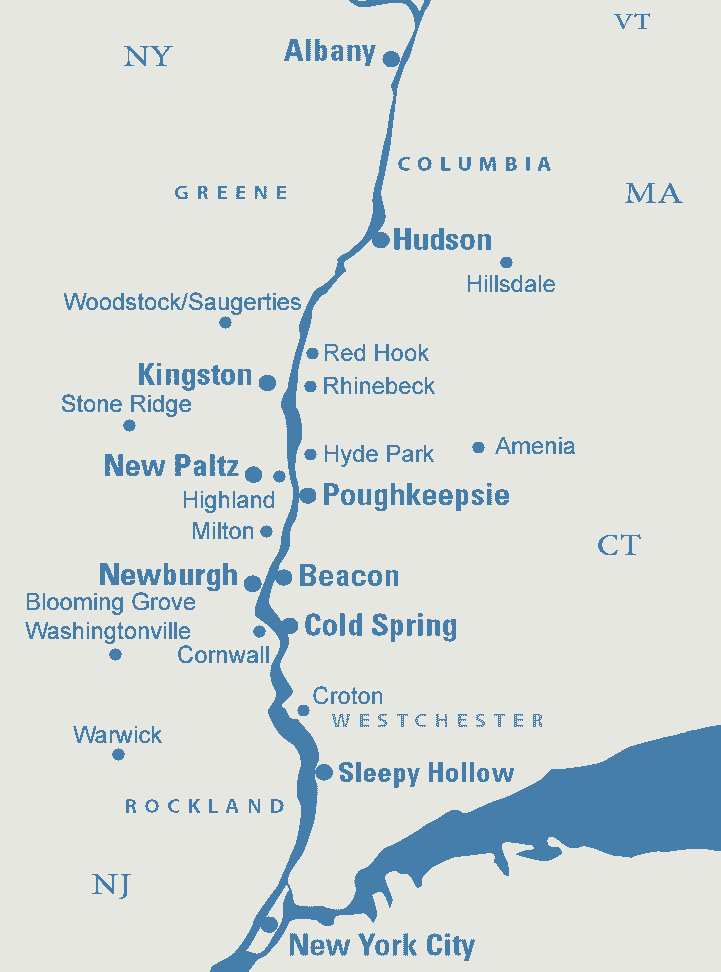
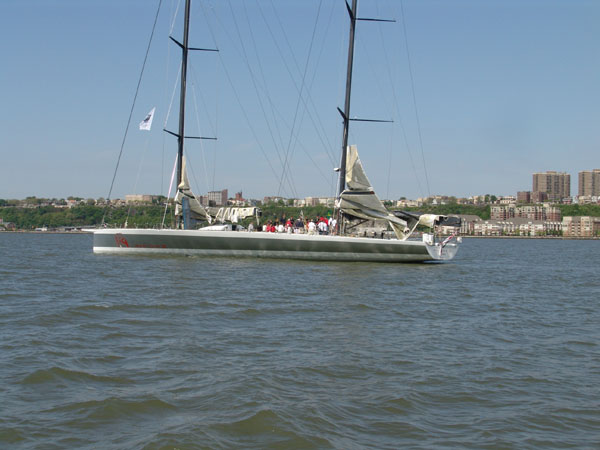
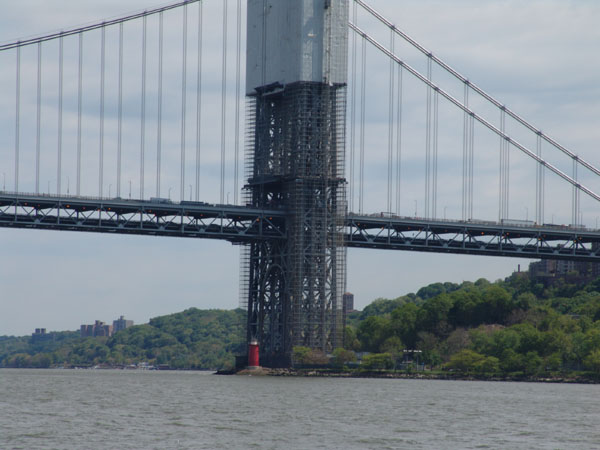 and
follow the clearly marked red and green markers to the marina entrance which is
also marked by a small lighthouse on the portside. The marina is protected
by a large wood wall bulkhead. The current is running and Larry feels the
pull as he crabs the line to the entrance. In the Hudson River, the tidal
range changes from 3 to 5 feet and the currents can run anywhere from 2 knots to
an average of 1.5 knots. It can slow you down in your travels against it
and can also be a difficulty when docking depending on the protection the marina
offers. As we enter the marked channel, the water is shallow and as we
enter the confines of the bulkhead it really becomes shallow.
and
follow the clearly marked red and green markers to the marina entrance which is
also marked by a small lighthouse on the portside. The marina is protected
by a large wood wall bulkhead. The current is running and Larry feels the
pull as he crabs the line to the entrance. In the Hudson River, the tidal
range changes from 3 to 5 feet and the currents can run anywhere from 2 knots to
an average of 1.5 knots. It can slow you down in your travels against it
and can also be a difficulty when docking depending on the protection the marina
offers. As we enter the marked channel, the water is shallow and as we
enter the confines of the bulkhead it really becomes shallow. 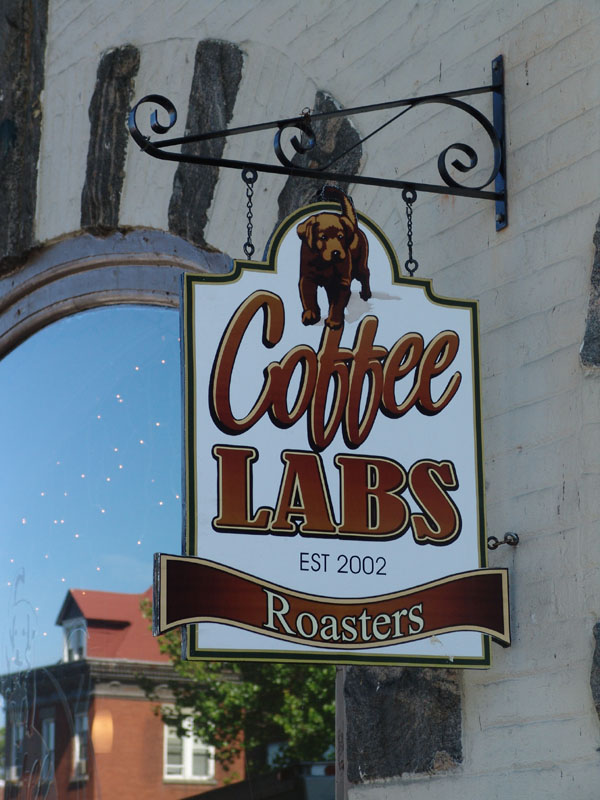
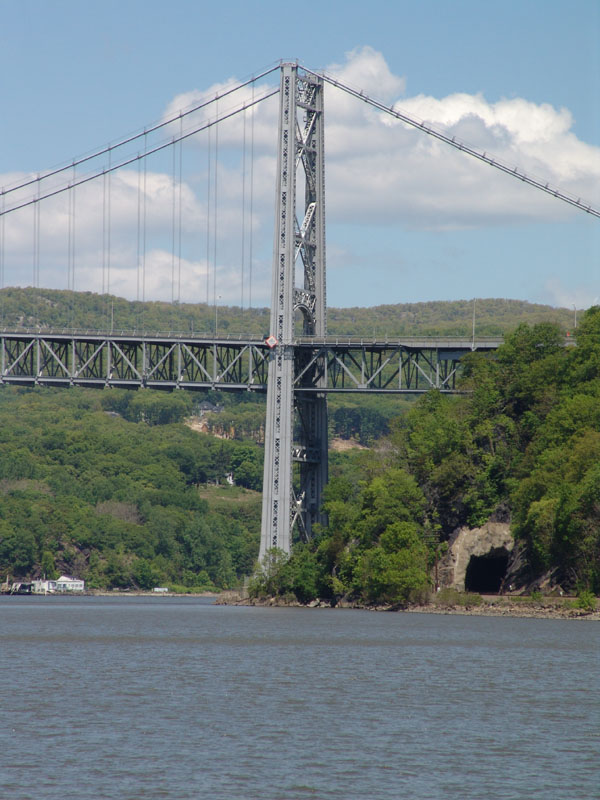 UP
THE RIVER TO NEWBURGH
UP
THE RIVER TO NEWBURGH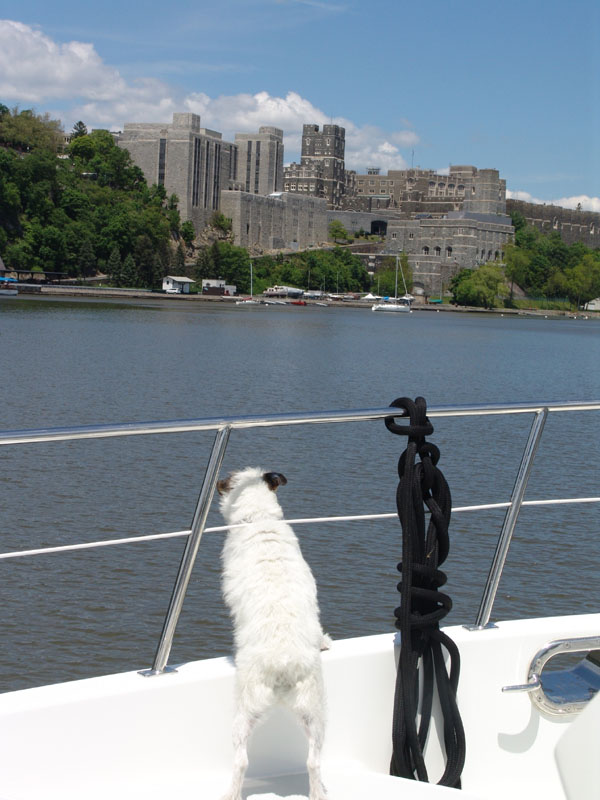 As
you pass under Bear Mountain Bridge you suddenly get a straight view up river
and you can make out the massive structure of West Point. At first you
canít believe it. Itís a massive stone fortress. Itís ominous and
forbidding as it sitting dominantly on the steep side of the river. It is
an impressive site. A wonder to see from the river. West Point was
strategically placed at the narrowest stretch of the Hudson River to protect the
upper reaches. Because of itís location at the narrowest point, Washington
chose this location to stretch a second massive chain across 500 yards of the
river to hold off the British. Unfortunately, they were unsuccessful in
holding them back and the British continued on up river to eventually burn to
the ground the village of Kingston.
As
you pass under Bear Mountain Bridge you suddenly get a straight view up river
and you can make out the massive structure of West Point. At first you
canít believe it. Itís a massive stone fortress. Itís ominous and
forbidding as it sitting dominantly on the steep side of the river. It is
an impressive site. A wonder to see from the river. West Point was
strategically placed at the narrowest stretch of the Hudson River to protect the
upper reaches. Because of itís location at the narrowest point, Washington
chose this location to stretch a second massive chain across 500 yards of the
river to hold off the British. Unfortunately, they were unsuccessful in
holding them back and the British continued on up river to eventually burn to
the ground the village of Kingston. 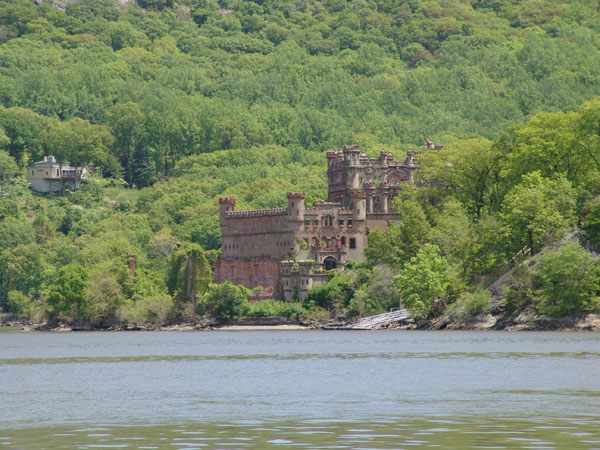 As
we come around the turn in the river past Cold Spring we see the strangest site,
itís the ruins of a castle-like structure. It is the last remains of what
had been known as
Bannermanís Island Arsenal. It was built by Frank Bannerman to
resemble an old Scottish Castle. Frank Bannermanís family emigrated from
Scotland in 1854. Frankís father went into the business of selling flags,
ropes and other items that he bought at navy auctions. When Frankís father
joined the union army during the Civil War, the then 13 year old Frank, took
over the family business and began his successful career with keen skill at
purchasing discarded scrap, weapons and military supplies from the US
Government. He turned this into a very successful business by reselling
the items to the public. It became big business and by the early 1900ís
his supply of military goods was astonishing. He began selling to foreign
countries and could literally supply a whole nation with enough equipment and
weapons to go to war. He needed a place to store the arsenal and thatís
what Pollepel Island became. In the 1960ís the family still owned and ran
the business. They sold such odd items as African arrows, saddles from
Morocco, pith helmets, and much more. It is said that they completely
outfitted Buffalo Billís traveling road show and many movies. Times change
and in the late 60ís the collection was given to the Smithsonian and the castle
sold to NY State. Unfortunately a great fire almost completely destroyed
the castle and now just remnants remain with only hints at its previous history.
As
we come around the turn in the river past Cold Spring we see the strangest site,
itís the ruins of a castle-like structure. It is the last remains of what
had been known as
Bannermanís Island Arsenal. It was built by Frank Bannerman to
resemble an old Scottish Castle. Frank Bannermanís family emigrated from
Scotland in 1854. Frankís father went into the business of selling flags,
ropes and other items that he bought at navy auctions. When Frankís father
joined the union army during the Civil War, the then 13 year old Frank, took
over the family business and began his successful career with keen skill at
purchasing discarded scrap, weapons and military supplies from the US
Government. He turned this into a very successful business by reselling
the items to the public. It became big business and by the early 1900ís
his supply of military goods was astonishing. He began selling to foreign
countries and could literally supply a whole nation with enough equipment and
weapons to go to war. He needed a place to store the arsenal and thatís
what Pollepel Island became. In the 1960ís the family still owned and ran
the business. They sold such odd items as African arrows, saddles from
Morocco, pith helmets, and much more. It is said that they completely
outfitted Buffalo Billís traveling road show and many movies. Times change
and in the late 60ís the collection was given to the Smithsonian and the castle
sold to NY State. Unfortunately a great fire almost completely destroyed
the castle and now just remnants remain with only hints at its previous history.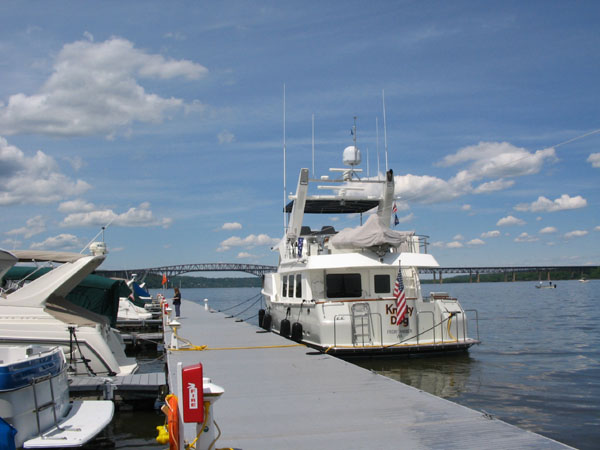 After
passing Pollepel Island we can see Newburgh ahead which will be our home port
for a few days. We hail the dock master by radio but no answer. We
finally reach him by cell phone. Guess thatís the new trend these days.
We are given instructions to side tie to the dock right along side the river.
As we make our approach, we make a turn down river so we can do a starboard tie
as thatís what our boat is set up for. The dock master waves us off and
insists that we tie up facing the other direction. So, complying with his
wishes, we change lines and fenders to the opposite side. Our boat is
designed to have an easy starboard tie. The walk around deck is on that
side and it just makes it easier to get on and off but really we can do either.
Once we were securely tied to the dock, the dock master, a kind of flashy New
Yorker type, tells us ďyou donít want to be facing down river if the weather
changes for the worstĒ and he says thatís why he changed direction on us.
He said if the wind starts to blow south we can always take refuge on the south
end of the dock and vice versa for a north wind. This gave me much thought
for the rest of our stay as I was wondering what that all meant. During
our stay we got some strong weather and winds (Iíd say a turn for the worse) at
certain times of the day, mostly in the late afternoon but nothing required us
to change position like he said. The most troubling problem at this dock
were the constant wakes made by the gazillion little recreational fishing boats
that were racing back and forth, up and down the river as fast as they could go.
They had no concept of the wakes they were creating or consideration for the
discomfort and annoying roll it gave us. It was a miserable stay at this
marina for this reason. At some times I just wanted to yell at them with a
huge mega phone but what would be the use as they all did the same thing.
It went on all day long from early dawn until late into the evening. It
was so annoying.
After
passing Pollepel Island we can see Newburgh ahead which will be our home port
for a few days. We hail the dock master by radio but no answer. We
finally reach him by cell phone. Guess thatís the new trend these days.
We are given instructions to side tie to the dock right along side the river.
As we make our approach, we make a turn down river so we can do a starboard tie
as thatís what our boat is set up for. The dock master waves us off and
insists that we tie up facing the other direction. So, complying with his
wishes, we change lines and fenders to the opposite side. Our boat is
designed to have an easy starboard tie. The walk around deck is on that
side and it just makes it easier to get on and off but really we can do either.
Once we were securely tied to the dock, the dock master, a kind of flashy New
Yorker type, tells us ďyou donít want to be facing down river if the weather
changes for the worstĒ and he says thatís why he changed direction on us.
He said if the wind starts to blow south we can always take refuge on the south
end of the dock and vice versa for a north wind. This gave me much thought
for the rest of our stay as I was wondering what that all meant. During
our stay we got some strong weather and winds (Iíd say a turn for the worse) at
certain times of the day, mostly in the late afternoon but nothing required us
to change position like he said. The most troubling problem at this dock
were the constant wakes made by the gazillion little recreational fishing boats
that were racing back and forth, up and down the river as fast as they could go.
They had no concept of the wakes they were creating or consideration for the
discomfort and annoying roll it gave us. It was a miserable stay at this
marina for this reason. At some times I just wanted to yell at them with a
huge mega phone but what would be the use as they all did the same thing.
It went on all day long from early dawn until late into the evening. It
was so annoying. 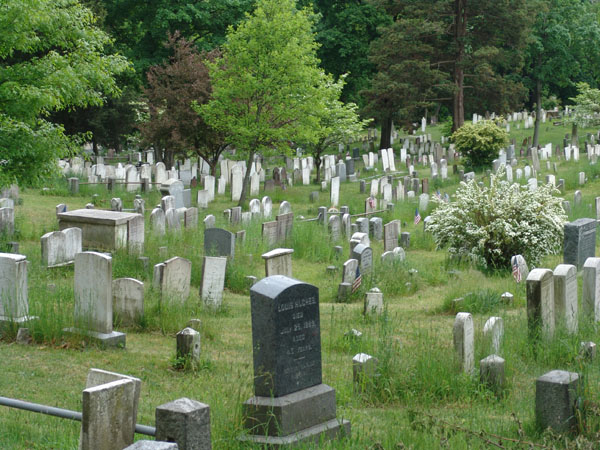 By
lunch time we had seen much of the lovely countryside and passed many old
mansions along the roadside that were built along the Eastern shore of the
Hudson River. We reached the town of
Sleepy Hollow just in time to stop in a small cafť for lunch.
Nearby was the Sleepy Hollow Graveyard and Headless Horseman Bridge
that so inspired the great stories of Washington Irving. We wondered
through the amazing cemetery not to be morbid but get the feel for the great
story
Sleepy Hollow and the Headless Horseman. The cemetery, if I can
say so, is a wonderful place with antique grave stones and interesting
mausoleums. Itís a hilly place shaded by huge old flowering trees and
rhododendron bushes that grace the tombstones. The pathways are grass and
dirt and well worn with carriage ruts. The designs of some of the
mausoleums are elaborate and thought provoking. It was fascinating to say
the least. Nearby on the edge of the cemetery is the Old Dutch Church
and just across the way is the
Headless Horsemanís Bridge ďlocationĒ. All well, it canít all still
be there, so if you can block out in your mind the traffic signal, trucks and
cars rushing by, you really can imagine the Headless Horseman, galloping across
the bridge in and wild chase to catch Ichabod, who in his lanky way was hanging
on for dear life to the neck of his clumsy slow old mare. Itís all in your
imagination anyway, right?
By
lunch time we had seen much of the lovely countryside and passed many old
mansions along the roadside that were built along the Eastern shore of the
Hudson River. We reached the town of
Sleepy Hollow just in time to stop in a small cafť for lunch.
Nearby was the Sleepy Hollow Graveyard and Headless Horseman Bridge
that so inspired the great stories of Washington Irving. We wondered
through the amazing cemetery not to be morbid but get the feel for the great
story
Sleepy Hollow and the Headless Horseman. The cemetery, if I can
say so, is a wonderful place with antique grave stones and interesting
mausoleums. Itís a hilly place shaded by huge old flowering trees and
rhododendron bushes that grace the tombstones. The pathways are grass and
dirt and well worn with carriage ruts. The designs of some of the
mausoleums are elaborate and thought provoking. It was fascinating to say
the least. Nearby on the edge of the cemetery is the Old Dutch Church
and just across the way is the
Headless Horsemanís Bridge ďlocationĒ. All well, it canít all still
be there, so if you can block out in your mind the traffic signal, trucks and
cars rushing by, you really can imagine the Headless Horseman, galloping across
the bridge in and wild chase to catch Ichabod, who in his lanky way was hanging
on for dear life to the neck of his clumsy slow old mare. Itís all in your
imagination anyway, right?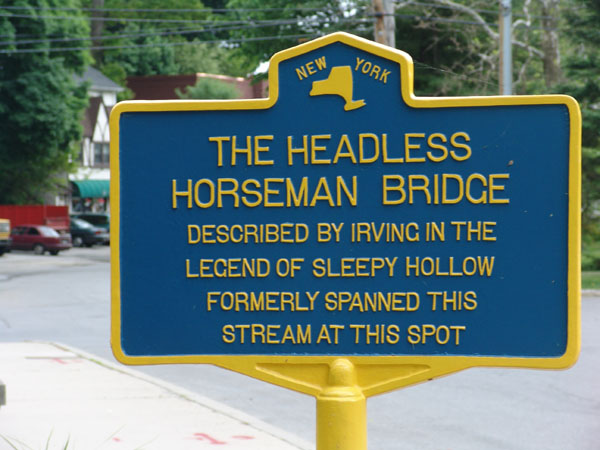 It
was a place unique and different from the surrounding areas along the
river. The house is storybook-like draped in huge old blooming wisteria
vines that magically twisted their way around the doors and windows. I can
easily see and feel the mysterious inspiration Washington Irving generated from
these wonderful images.
It
was a place unique and different from the surrounding areas along the
river. The house is storybook-like draped in huge old blooming wisteria
vines that magically twisted their way around the doors and windows. I can
easily see and feel the mysterious inspiration Washington Irving generated from
these wonderful images.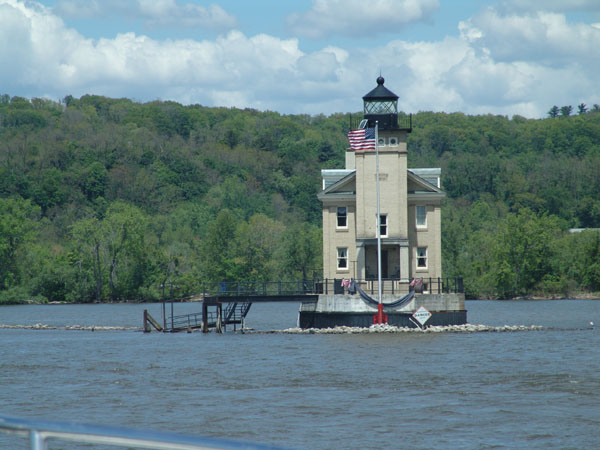 As
we round up past Prospect Hill, we can see the entrance to Kingston
our next destination. We see the famous little light house that greats you
at the entrance to Roundout Creek at Kingston. As we pass the
little lighthouse we see old wooden boats along the river, one is an old tug,
another is a old wooden Dutch like vessel. In the near distance we see the
Sleightsburg Bridge anchoring the town of Kingston and to our right is the
Kingston Maritime Museum which is our dock destination and home the next
couple of days.
As
we round up past Prospect Hill, we can see the entrance to Kingston
our next destination. We see the famous little light house that greats you
at the entrance to Roundout Creek at Kingston. As we pass the
little lighthouse we see old wooden boats along the river, one is an old tug,
another is a old wooden Dutch like vessel. In the near distance we see the
Sleightsburg Bridge anchoring the town of Kingston and to our right is the
Kingston Maritime Museum which is our dock destination and home the next
couple of days. 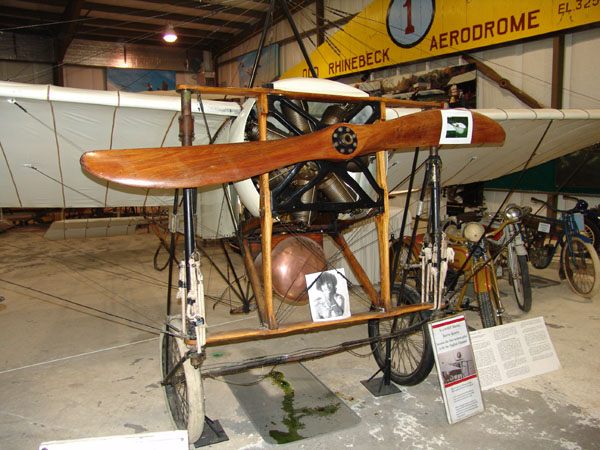 Since
Dave was a pilot, we decided it would be fun to visit the Old Rhinebeck
Aerodrome right outside of Rhinebeck, nestled back off some country road.
Itís an amazing place with a wonderful collection of antique airplanes dating
back to the very beginnings of mans attempts at flight. Some are so fragile and
lightweight you would never imagine that they would be safe to fly in, and I
suppose they werenít. A nice gentleman docent gave us a great tour of the
main warehouse and then we wondered the grounds and other warehouses, just
amazed at the collection. They had other antique treasures of unique modes
of transportation on display too, like funny cars and motorcycles. Itís a
fun place.
Since
Dave was a pilot, we decided it would be fun to visit the Old Rhinebeck
Aerodrome right outside of Rhinebeck, nestled back off some country road.
Itís an amazing place with a wonderful collection of antique airplanes dating
back to the very beginnings of mans attempts at flight. Some are so fragile and
lightweight you would never imagine that they would be safe to fly in, and I
suppose they werenít. A nice gentleman docent gave us a great tour of the
main warehouse and then we wondered the grounds and other warehouses, just
amazed at the collection. They had other antique treasures of unique modes
of transportation on display too, like funny cars and motorcycles. Itís a
fun place.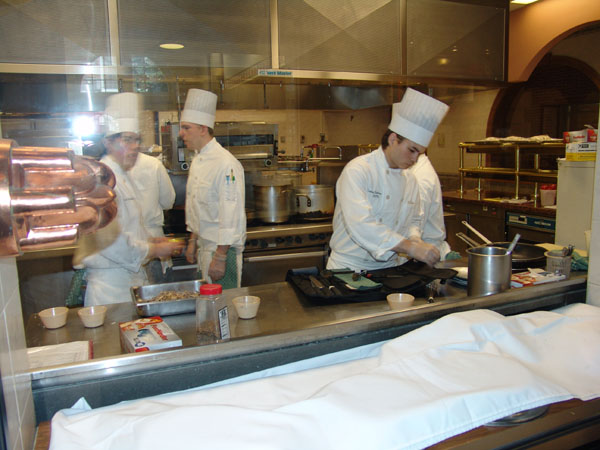 Everyone
and anyone will enjoy this place. We made a reservation for lunch and
arrived about an hour before to allow us time to explore the campus. It
would have been great to have had the foresight to make a previous reservation
for a tour but the days the tours were available didnít work with our schedule.
So if you come here and are interested, check ahead and be sure and take one.
They are reasonable and Iíve heard they are fascinating. We managed to
sneak around a little and see quite a few interesting demonstrations as it was.
They have several restaurants to choose from if you plan ahead. We were
only able to get in to the Medici as our other choices were all completely
booked. The restaurant wasnít disappointing though as we had a fabulous
meal and everything was more than delicious. The staff waited on us hand
and foot, down to the request by Diane for heavy cream in her coffee. They
had half and half but she said she liked heavy cream so the waitress made a
special search to another building to get some from the pastry chef. Wow,
what service!
Everyone
and anyone will enjoy this place. We made a reservation for lunch and
arrived about an hour before to allow us time to explore the campus. It
would have been great to have had the foresight to make a previous reservation
for a tour but the days the tours were available didnít work with our schedule.
So if you come here and are interested, check ahead and be sure and take one.
They are reasonable and Iíve heard they are fascinating. We managed to
sneak around a little and see quite a few interesting demonstrations as it was.
They have several restaurants to choose from if you plan ahead. We were
only able to get in to the Medici as our other choices were all completely
booked. The restaurant wasnít disappointing though as we had a fabulous
meal and everything was more than delicious. The staff waited on us hand
and foot, down to the request by Diane for heavy cream in her coffee. They
had half and half but she said she liked heavy cream so the waitress made a
special search to another building to get some from the pastry chef. Wow,
what service!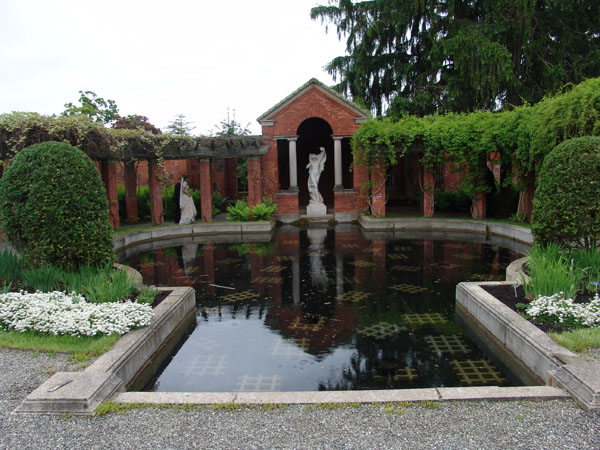 We
couldnít help but to go see the Vanderbilt Estate, especially since we
saw it from the river. The grounds are expansive. We walked the
estate and marveled at the massive house, much like a bank building rather than
a home. The estate wasnít warm or friendly but stark, cold and uninviting.
The grounds were beautiful. We walked along a path that followed the ridge
along the river. The path had vistas both up and down the Hudson River.
We walked through their formal garden area. The grounds are beautiful and
the path along the river actually link all the way down river to FDRís house.
Itís about a 3.5 mile hike.
We
couldnít help but to go see the Vanderbilt Estate, especially since we
saw it from the river. The grounds are expansive. We walked the
estate and marveled at the massive house, much like a bank building rather than
a home. The estate wasnít warm or friendly but stark, cold and uninviting.
The grounds were beautiful. We walked along a path that followed the ridge
along the river. The path had vistas both up and down the Hudson River.
We walked through their formal garden area. The grounds are beautiful and
the path along the river actually link all the way down river to FDRís house.
Itís about a 3.5 mile hike. 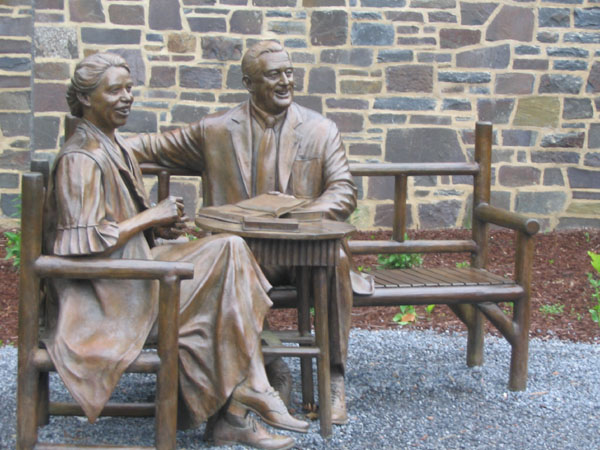 Not
to be missed was
Val-Kill, Eleanor Rooseveltís small and modest retreat back off away from
the river. The house is not much as far as style and beauty but the
surrounding grounds are lovely. The house is anchored by a peaceful pond
and grounds that isolate the estate from any surrounding roads, buildings or
city. You could easily imagine why this was her favorite retreat. It
was peaceful and serene, and almost surreal as perfect white swans preened
themselves in a perfect pond.
Not
to be missed was
Val-Kill, Eleanor Rooseveltís small and modest retreat back off away from
the river. The house is not much as far as style and beauty but the
surrounding grounds are lovely. The house is anchored by a peaceful pond
and grounds that isolate the estate from any surrounding roads, buildings or
city. You could easily imagine why this was her favorite retreat. It
was peaceful and serene, and almost surreal as perfect white swans preened
themselves in a perfect pond.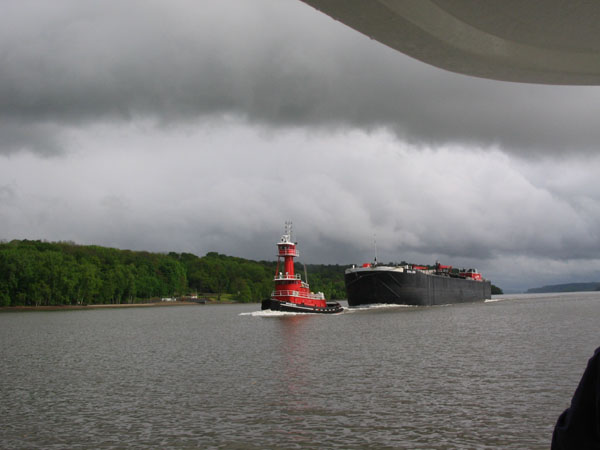 It
was overcast and predictions and actuations of thunderstorms and rain were to
plaque our journey today. My friend, Greg from Boston, sent an email
saying they were having a horrible
Norí Easter up there. Guess weíre lucky that weíre up the Hudson and
well protected. It has been a strange spring, very cold and rainy.
We thought weíd be in shorts and t-shirts by now but still have winter cruising
clothes on.
It
was overcast and predictions and actuations of thunderstorms and rain were to
plaque our journey today. My friend, Greg from Boston, sent an email
saying they were having a horrible
Norí Easter up there. Guess weíre lucky that weíre up the Hudson and
well protected. It has been a strange spring, very cold and rainy.
We thought weíd be in shorts and t-shirts by now but still have winter cruising
clothes on.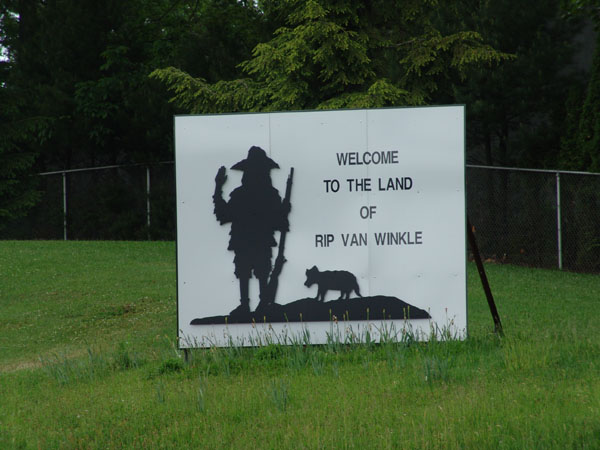
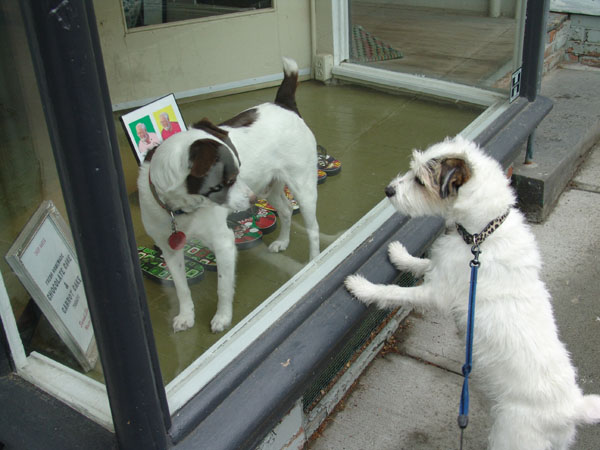 We
took the recommendation of the people at City Hall and stopped to sneak an
illegal look at Haines Falls since we didnít have the day to hike to the famous
Kaaterskill Falls. The Haines Falls were magnificent and storybook like as
the water cascaded from one mammoth granite precipice to the next, down the deep
canyon with distant views of the Hudson River Valley.
We
took the recommendation of the people at City Hall and stopped to sneak an
illegal look at Haines Falls since we didnít have the day to hike to the famous
Kaaterskill Falls. The Haines Falls were magnificent and storybook like as
the water cascaded from one mammoth granite precipice to the next, down the deep
canyon with distant views of the Hudson River Valley. 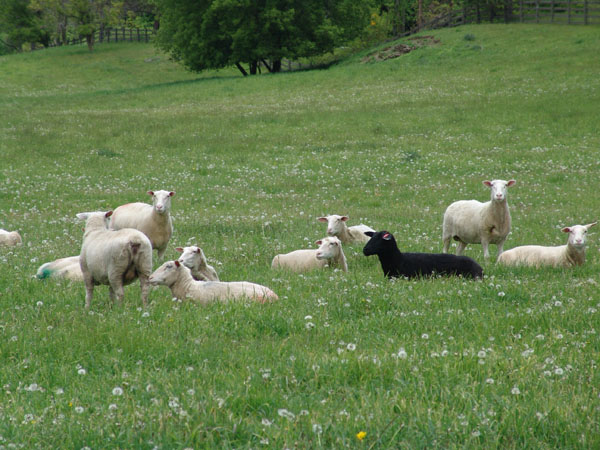
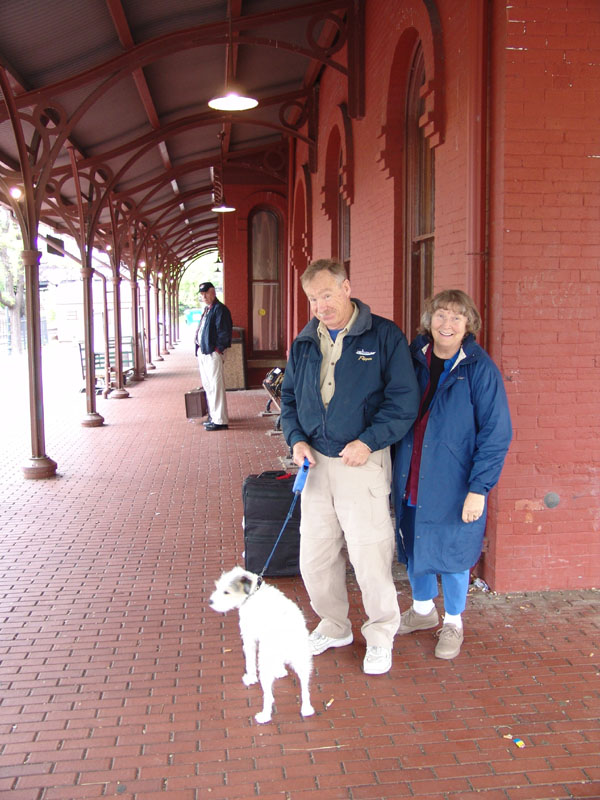 Well,
it was time for our friends to go and we dropped them off at the train station
heading for Albany. In Albany, they would pick up a rental car and explore
Lake Champlain, Vermont and Maine on their own and then fly back to Santa
Barbara.
Well,
it was time for our friends to go and we dropped them off at the train station
heading for Albany. In Albany, they would pick up a rental car and explore
Lake Champlain, Vermont and Maine on their own and then fly back to Santa
Barbara.